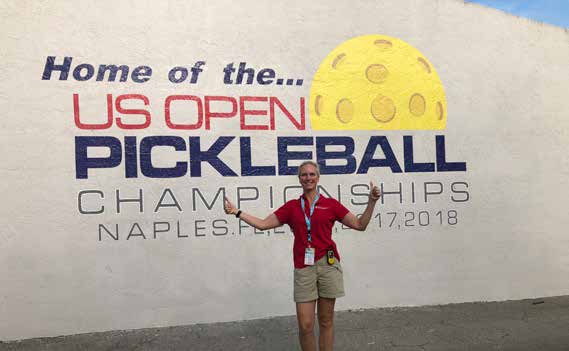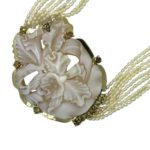PICKLEBALL DOCTOR Q & A by jeff lytle
 As the popularity of pickleball grows across Southwest Florida and the nation, the chance of injury is part of the fast-paced game. Dr. Christina Kabbash of Naples has special insights, as an on-site doctor at the annual U.S. Pickleball Open Championship taking place this year at the East Naples Community Park April 27-May 4.
As the popularity of pickleball grows across Southwest Florida and the nation, the chance of injury is part of the fast-paced game. Dr. Christina Kabbash of Naples has special insights, as an on-site doctor at the annual U.S. Pickleball Open Championship taking place this year at the East Naples Community Park April 27-May 4.
She is an orthopedic surgeon with fellowship training in foot and ankle conditions. “I take general trauma calls as well, so I fix broken bones, displaced joints and ruptured tendons from accidents and sports injuries all over the body,’’ she says.
Dr. Kabbash is on staff and has her office at the Physicians Regional Hospital on Pine Ridge Road in Naples. She operates there and at Physicians Regional on Collier Boulevard. She was kind enough to answer some fundamental questions on playing safely.
What do prospective players need to know about the sport?
Play within your limits!!! Pickleball is a very easy sport to pick up and highly addictive. It is easy to overdo it, placing excessive strain on your muscles and joints. While you may be in great condition from other athletic endeavors, pickleball requires a lot of sudden starting and stopping, lunging and twisting. The joint capsules, tendons and muscles need to build and toughen up to adapt to these stresses. Playing every day, without a day or two of rest in between, places you at risk for injury, especially if you are a new player. Pickleball will also test your balance and reflexes; these also need to be built up and strengthened over time.
Many people who play pickleball have played racquet sports in the past and remember how their bodies used to move, and may lunge for shots they have no business lunging for. Like any sport, speed, reflexes, muscle memory and strength all improve with time. Avoiding injury by ramping up slowly, with plenty of rest days, will optimize safety and performance.
Wear the appropriate court shoes. Court shoes for racquet sports have wide soles that slide allowing shuffling without “catching an edge” and good side-to-side stability.
Many of today’s running shoes have a rocker bottom sole which is good for heel to toe motion but will not support side-to-side motion as well as front-to back rolling motion. They also have treads optimized for traction which can result in catching and falling on a court.
Is pickleball a viable alternative to tennis for players who may be older or injured?
Pickleball is excellent for older tennis players with shoulder injuries. The paddle and ball are lighter than a tennis racquet and tennis ball, which reduces the impact on the shoulder and elbow when hitting the ball. There is no overhead serve, which is painful or impossible for athletes with rotator cuff tendinitis or tears. While the court is smaller, decreasing the amount of running around, the game does tend to be quicker, which can place increased twisting forces on the knees or hips. If playing pickleball is causing pain or swelling in the knees or hips, this should be addressed prior to continuing play.
Doubles pickleball will require less running and twisting, this may be an option. Also, court surfaces may make a difference. Cement or an asphalt parking lot will be harder on the ankles, knees and hips than a traditional pickleball/ tennis court surface.
What is the most common pickleball injury that you see, and can it be avoided?
The most common pickleball injuries I see are calf strains or ruptures, and less commonly, Achilles tendinitis or ruptures. Hamstring or groin pulls are also common, as are wrist sprains and fractures from falls. These injuries are more common in new or unconditioned players. Proper court shoes to avoid falls will help avoid wrist sprains and fractures. Playing within your limits, gradually increasing amount of play and intensity of play, with adequate rest in between, will decrease the risk of lower extremity injuries.
Many players are taught from the start to let a ball go if it is more than two steps away. Do you agree?
Lunging for a ball is the most common way patients trip and fall or injure their Achilles or calf muscles. Over time, players are able to better recognize what shots are achievable, and what should be let go, but this takes practice. If there is any doubt, let it go! There will be plenty more balls to whack behind it.
For more information about the U.S. Pickleball Open, go online to usopenpickleballchampionship.com; for Dr. Kabbash, call her office at 239.348.4221



Leave a Reply
Want to join the discussion?Feel free to contribute!